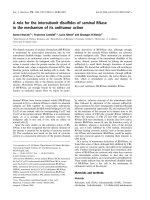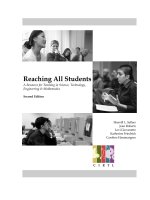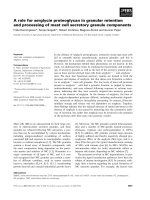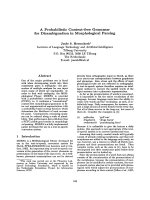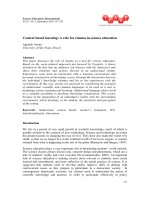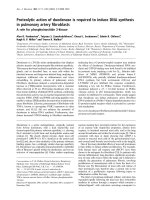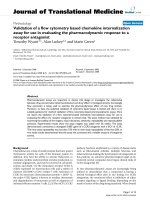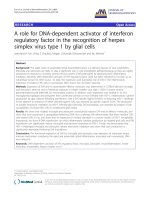Context based learning: A role for cinema in science education pdf
Bạn đang xem bản rút gọn của tài liệu. Xem và tải ngay bản đầy đủ của tài liệu tại đây (99.56 KB, 13 trang )
131
Science Education International
Vol.21, No.3, September 2010, 131-143
Context based learning: A role for cinema in science education
Agnaldo Arroio
University of São Paulo, Brazil
Abstract
This paper discusses the role of cinema as a tool for science education.
Based on the socio-cultural approach put forward by Vygotsky, it draws
attention to the fact that an audience can interact with the characters and
share their emotions and actions showed in an audiovisual setting.
Experiences come from an interaction with a learning environment and
personal construction of knowledge occurs through the interaction between
the individual´s knowledge schemes and his or her experiences with the
environment. In this way, movies are analysed by considering the potential
of audiovisual, scientific and common languages to be used as a tool to
mediating science teaching and learning. Audiovisual language shows itself
as a valuable possibility to facilitate knowledge construction. This occurs
because of the integration of an individual’s reality with the surrounding
environment, which develops, in the student, the sensitivity and perception
of the setting.
Keywords: Audiovisual, context based, teacher’s formation, ICT,
interdisciplinarity, Innovation.
Introduction
We live in a period of very rapid growth in scientific knowledge, much of which is
quickly utilized in the creation of new technology. Science and technology are today
the greatest factors in changing the way we live. They have also made the world very
small, so that we no longer live in the confined world of our town, region, or country
isolated from what is happening in the rest of the globe (Härnqvist and Burgen, 1997).
Science education plays a very important role in broadening students’ world outlook.
The science classes always discuss real, concrete things and phenomena, which are a
part of students’ reality and even everyday life (Lamanauskas, 2003). An important
task of science education is making science more relevant to students, more easily
learned and remembered, and more reflective of the actual practice of science. It is
suggested that students need to develop and/or improve skills in dealing with
controversial issues as they prepare to participate in a democratic society. In
contemporary democratic societies, lay citizens need to understand the nature of
scientific knowledge and practice, in order to participate effectively in policy
Agnaldo Arroio
132
decisions, and to interpret the meaning of new scientific claims which affect their
lives (Sandoval, 2005). Science educators thus seem to agree that relevant, real-life,
contexts are important when teaching for scientific literacy (Mork and Jorde, 2004).
According to recent research in science education, teachers have conceptions,
attitudes and actions related to science teaching supported by a lengthy environmental
training period in which they were students (Hewson and Hewson, 1988). It means
that there is a relevant influence of this incidental training that reiterates experiences
acquired in a non-reflexive manner as something natural, thus escaping criticism. If
some knowledge of science is accepted as part of the education of every student, there
is a need to think how best to provide that education (Lemke, 1990). It is therefore
important to think of education systemic term, not limiting the student’s experiences
to what can possibly take place in the classroom. The role of alternative learning
environments becomes critical as a prelude, a complement a follow-up to the school-
based learning process. Experiences come from interaction with a learning
environment.
As Holbrook (2010) point out:
Education cannot be developed in a vacuum. It needs a context and
this context, inevitably in science lessons, involves science content
and science conceptual learning. Thus, although science content
need not be specified and may be related to a contemporary context,
science lessons utilise the acquisition of scientific ideas to aspire to
playing their major role in the development of students through an
appropriate context.
The Socio-Cultural Approach
According to Lemke (2001) it is a falsification of the nature of science to teach
concepts outside of their social, economic, historical, and technological context.
Concepts taught in this way are relatively useless in life, however well they may seem
to be understood. Science and science education are always a part of larger
communities and their cultures, including the sense in which they take in social and
cultural conflicts that extend far beyond the classroom. In a socio-cultural approach,
learning involves being introduced to a symbolic world. Knowledge and
understandings including scientific understandings are constructed when individuals
engage socially in talks and activities about shared problems or tasks (Driver et all.,
1994).
The socio-cultural approach takes into account, in general, that the construction of
knowledge as a social process, where social transactions and discourse are considered
to be the basis for any subsequent learning. Representations of knowledge are viewed
as patterned by social and cultural circumstances. This view accentuates the social
and cultural genesis and appropriation of knowledge (Billet, 1996). Learning is
considered as an appropriation of socially derived forms of knowledge. Appropriation
is not restricted to the internalization of externally derived stimuli. It consists of a
Context based learning: A Role for Cinema in Science Education
133
transformational and reciprocal constructive process and results to a co-construction
process.
Vygotsky (1978) suggested that the language mediates the cultural transmission
process of knowledge acquired by humanity. Without the language, it is almost
impossible that teacher’s words make sense for the students. Knowledge can only be
learned through some process of social transmission (Leach and Scott, 2003). The
process of internalization is how students reorganize and reconstruct talks and
activities from the social plane of classroom. It seems that not involve direct transfer
of the discourse from the step involving personal interpretation where the individual
comes to a personal understanding of ideas encountered at the social plane (Mork and
Jorde, 2004).
It seems that students are not able to learn science on their own without guidance
from other persons or cultural tools. The term zone of proximal development (ZPD)
was introduced by Vygotsky (1978) to explain as the distance between what a person
can do by himself, without support from others, and what this person can do with
support from others or more skilled one. On this way, we consider that this kind of
support could be done by other cultural tools like books, ICT and in this case by a
movie.
The main reason for adopting a socio-cultural perspective as a theoretical framework
of analysis was our focus on understanding the relationship between communication,
learning and the socio-cultural context. Because in different contexts humans learn in
different ways, then individual tend to learn through communication rather than
discovery.
The language in the socio-cultural approach is considered extremely relevant in
socially negotiating and meaning making. The widening interest in situated learning
resides in the belief that learning is more closely linked to the circumstances of its
acquisition, and that these circumstances influence the transfer of knowledge to other
situations. These beliefs call for a close consideration of contributions of socio-
cultural approach to understand the role of social interactions in shaping meaning
making and the complexities of the situated knowledge on the classroom.
It is fundamental that the teacher investigates what are the situations that could create
interest and how it can be worked and articulated to the scientific topics, because it
becomes a convincing act by showing to the students other ways to dialogue
concerning reality. Personal construction of knowledge occurs through the interaction
between the individual´s knowledge schemes and his or her experiences with the
environment. Science education must encourage the development of creative thinking
(Laius and Rannikmäe, 2005).
Science teaching can be conceptualized in terms of introducing learner to one form of
the social language of science. A distinction can be drawn between the everyday
social language and the scientific school language. The science, which is taught in
school, is a simplification of real science and for example takes into consideration the
age of the students. According to Leach and Scott (2000) the concept of learning
demands to describe the differences between the scientific school language and the
Agnaldo Arroio
134
social language, which the student brings to the classroom (Sormunen and Saari,
2006).
Knowledge is stored in various discourses, linguistic contexts and acquires meaning
and significance only in these contexts. Marková (1996) describes this connection as
different social realities provide different experiences. As well, it leads to different
ways of seeing the world and consequently leads to different beliefs concerning our
comprehension of the world. So, words and terms which are used acquire meaning in
the contexts where they are used. The relevant perspective within a sector is decisive
for how a question, a problem, a statement is to be interpreted, what is interesting,
pertinent an objective.
According to Schoultz and Hultman (2004), learning and development become ways
to learn and they have been developed in a special culture. In this perspective, science
can be viewed as a specific culture or indeed a group of sub-cultures, which have
developed over a long period of time. Learning science is related to participating in
activities, which offer a scientific way of thinking and acting. But this is not easy and
perhaps not even possible in a traditional school context because it is expected that
students must cross over certain discursive and linguistic borders.
A scientific discourse contextualizes reality in a way which differs from a more
everyday way of reasoning and the essential meaning of words and terms. So the
distance between the everyday world and the scientific world of the traditional school
is often so great that it seems impossible for student to benefit from the teaching
(Jakobsson, 2001). Säljö (1996) indicates that language use and the construction of
meaning are always social processes, dependent on people who interact. Meaning is
always relative to options and constraints that are present in social situations.
Learning science means learning to control the use of scientific language. In this way,
it is important to use this specialized conceptual language in reading, writing, problem
solving and guiding practical action in the laboratory and also in daily life.
The Role of Cinema
This paper discusses the role of cinema as a tool for science education. By presenting
a movie, not only the content is transmitted, but experiences of all kinds: emotions,
feelings, attitudes, actions, knowledge, etc., as the cultural acquisition can give to
individual symbolic systems of reality´s representation (Arroio, 2007a). Movies create
trends and have a broader impact on students than any other media. Besides movies
are able to create interest in scientific themes (Serra and Arroio, 2008).
On several occasions the possibilities of cinema and television as teaching
instruments have been overestimated. It was thought, for instance, that the teacher
could be miraculously replaced by an audiovisual. The enthusiasm for the language of
images led some to believe that the transmission of ideas through audiovisual
perception could take the place of verbal language. Many persons with conservative
outlooks on teaching have prejudicially underestimated the rational use of audiovisual
means by misrepresenting their functions and, not taking advantages of the real
possibilities (Brake et al, 2003).
Context based learning: A Role for Cinema in Science Education
135
An artistic manifestation, as audiovisual language, shows itself as another possibility
or facilitating tool during knowledge construction. This occurs because of the
integration of individual reality with the natural surrounding environment, which
develops, in the student, the sensitivity and perception of the universe. The
audiovisual language allows such integration of the individual-environment, because
it deals with scientific concepts as well as showing characters living in a world that
can be recognized and identified by the students (Serra and Arroio, 2009). Using the
audiovisual language, it is possible to join science, teaching and learning in a way that
the communication becomes more efficient and learning more effective, besides
raising interest and motivation of students in science. Another important aspect is that
movies are an information source, like other media, directly influencing the
perceptions and conceptions of the students. It this way they help in the acquisition of
information process, contributing to the development of students critical sense.
Science fiction media combine science and pseudoscience for entertainment. It allows
an opportunity to compare and contrast two drastically different eras of life on this
planet. It also addresses the ethics of technological advancement (Rose, 2003). We
believe that with the appropriate supporting materials and science teachers trained in
using this new technique. Audiovisual can help reverse the negative attitudes that
many students have toward real science by moving them from familiar experiences
they enjoy to unfamiliar experiences they expect to be dull and difficult like learning
physics, biology and chemistry (Dubcek et al, 2003).
A movie is a multimedia narrative form, based on a physical record of sounds and
motion pictures. A movie is also a performed genre in the sense that it is primarily
designed to be show in a public performance. Whereas a dramatic play is realized as a
live performance by actors on a stage, a movie is show in a cinema, not as a live
event, and can theoretically be repeated infinitely without change. Like drama, a
movie is a narrative genre because it presents a story (a sequence of action units).
It is assuming that a movie, like a play, is a mainly a genre designed to be performed,
a genre that “comes to life” in a performance. Watching a movie, like watching a
play, is a collective public experience and a social occasion. Movie viewers’ come in
large numbers for (mostly unconscious) expectations about how the film medium
presents a real or fictional story. Above all, one generally assumes that the movie
creates a verisimilar or at least likely world, a world that runs on laws of nature and
logics. It is compatible with what might count as a fact or a possible experience in our
own world; it is the movies’ reality effect (Barthes, 1982).
Methodology
This paper report on a movie analysis (Jahn, 2003) considering a Vygotskian
perspective (Vygotsky, 1978) about contextualizing the scientific content.
Audiovisual sources has an undeniable influence on the quality and quantity of
experiences which make up the cognitive domain of youngsters today, given that
watching TV, for example, is the second activity, after sleep, to which children devote
most time (Fisch at al, 1997).
Agnaldo Arroio
136
In preparation for teaching, it is necessary to view a movie a number of times.
1. First, select some commercial movies, looking for ways to take educational
advantage of them. In this primary viewing it is necessary to focus on the
audiovisual language to realize if this movie is able to communicate with the
audience (students), youngsters in particular.
2. The second viewing is to focus on the scientific content presented on scenes in
the movie.
3. The third viewing focuses on the way the scientific knowledge is presented,
checking for possible mistakes and to think how the science can be
contextualized in the science classroom.
4. A fourth viewing is important to select and edit short sequences more suitable
for use in the teaching and learning of science.
5. The next step is to use these episodes to organize classroom’s activities based
on selected episodes of the movie as a cultural tool to contextualize the
scientific content and motivate students in science classes.
The analysis relates to the Erin Brockovich film which focuses on environmental
problems. Nowadays we consider environmental problems are areas for contemporary
discussion, especially about climate change. So this movie seems to be really an
important tool to contextualize and engage students to this scientific content that have
a strong influence in our life.
In a world where heroes are often in short supply, the story of Erin Brockovich is an
inspirational reminder of the power of the human spirit. Erin Brockovich, a 2000
movie, dramatizes the story of Erin Brockovich’s first fight against the West Coast
energy giant, Pacific Gas & Electric Company (PG&E).
Erin Brockovich is an unemployed single mother, desperate to find a job, but having
no luck. This losing streak even extends to a failed lawsuit against a doctor in a car
accident she was in. With no alternative, she successfully browbeats her lawyer to
give her a job as compensation for the loss. While no one takes her seriously, with her
trashy clothes and earthy manners, that soon changes when she begins to investigate a
suspicious real estate case involving the Pacific Gas & Electric Company. What she
discovers is that the company is trying quietly to buy land that is contaminated with
hexavalent chromium, a deadly toxic waste that the company is improperly and
illegally dumping and, in turn, poisoning the residents in the area. As she digs deeper,
Erin finds herself a leading figure in a series of events that would involve her law firm
in one of the biggest class action lawsuits in American history against a multi-billion
dollar corporation (IMDb, 2010).
The following is a description of a scene where it is possible to discuss scientific
content, especially the problem of corrosion and chromium pollution.
Erin visits a professor at a nearby college to learn more about chromium and finds
out that there are actually a couple kinds of chromium and that the harmful
chromium (VI) can cause a wide variety of very serious health problems in the
Context based learning: A Role for Cinema in Science Education
137
case of prolonged exposure. The professor also tells Erin that chromium (VI) is in
the water used to cool piston engines at factories to prevent corrosion.
As suggested by the professor in the movie, Cr (VI) is added to the water used to
cool the engines. This caused the contamination of the ground water of the areas
surrounding the PG&E plant. Hexavalent chromium is used in the industrial setting
to make dyes and pigments as well as bricks for furnaces. It is also used in the
tanning of leather and to preserve wood. The Pacific Gas & Electric Company
(PG&E) used it in their piston engines to prevent corrosion.
Chromium is a transition metal which can have different oxidation states that result
in different properties and reactions with other chemicals. Two common forms of
chromium are trivalent chromium, Cr (III)) and hexavalent chromium – Cr (VI).
Trivalent chromium is more common in natural settings and commonly found in
soil whereas hexavalent chromium can be found in industrial settings and is not as
safe as Cr (III). The hexavalent chromium, also referred to as chromium (VI), or
Cr
+6
, described by the professor in this scene is the dangerous form of chromium.
Discussion
As we can notice, the character Erin is a normal person like everybody, and most of
the people can establish a relationship like, identification process with this character.
Her problems are the same as our everyday problem. The problems are real like the
ones experiences in everyday life. She is human like us. One problem is presented
when chromium (VI) is ingested by the residents in the area due to its presence in
their water. Among problems caused by ingesting chromium (VI) are various forms of
cancer, respiratory diseases, kidney failure, gastrointestinal problems, reproductive
problems, as well as nosebleeds, headaches, benign (non-cancerous) tumours, and
hair loss. Workers in plants where chromium (VI) is present also experience problems
when inhaling and when it comes in contact with their skin. The emotions are a way
to engage students in the class activities. It is possible to propose a discussion about
health problem from the environmental pollution. Many phenomena in nature are
complex and require explanations using multiple perspectives (Girwidz et al, 2006).
The movie show different medical cases of residents and many of the side effects are
indicated.
With the audience engaged in this context based audiovisual, the teaching comprises
of activities associated with the movie, enabling the learner to participate effectively
in the activities of a more scientific nature. In this way, learning can be considered as
a process of enculturation by participation in shared activities. When students have an
opportunity to discuss about socio-scientific issues (for example, the problem of
chromium contamination), they can change from one socio-cultural context to
another. The issue arises as to what is more important, based on the movie context -
persons keeping their jobs, or to take care of their health? This context, catching
student’s attention also through emotions, seems to be able to promote the community
aspects of the classroom and the role of peer discussion in supporting students to learn
science.
Agnaldo Arroio
138
Showing a movie in the classroom seems to be more relevant, instead of just
memorizing the content for exams. It is considered a mature understanding of science
when the learners can demonstrate in terms of their ability ways to adapt to talking
and thinking about phenomena according to the context, recognising the
appropriateness, power and limitations of each (Leach and Scott, 2003). The movie
presents an opportunity to discuss specific content with students, but in a
contextualized way. It is possible to contextualize the corrosion process showing it as
a result of reactions between a material, typically a metal, and its environment.
Socio-cultural views of learning endorse the view that knowledge is socially
constructed and context dependent, and that human mental processes are structured
within their historical, cultural and institutional setting (Wertsch, 1991). The
audiovisual context based approach can provide students with a way to come to a
personal understanding of ideas and information that already exist in their culture
from their interaction during the discussion with the teacher and their peers about the
scenes from movie related to socio-scientific issues.
It is proposed that the learning of science is to improve our lives, not just to get
success on the school exams. Through movies it is possible to find science outside the
school and realize how important science is to us. Science is thus realised as a
complex of specific, situated human social and cultural activities. Science as a total
system of social activities is not merely research science; it includes all the use of
scientific practices at workplace, at home, in the environment. It is science as science
is done and used by those who are trained to use it according to the norms of our
society.
These assumptions are very helpful because they can be actively exploited when
students face difficult, incomprehensible, or illogical data. The most common strategy
in this case is to “naturalize” the information so that it becomes interpretable
according to the context. Learning results from student’s active and purposeful
involvement in activities. This enables them to process and interpret the information
from audiovisual context on the basis of their existing structure of knowledge and
experiences. It occurs through interactive cooperation and aids individual learning,
sometimes independently and sometimes collectively. It allows the students to gain
through diversity of the learning environment a way to focus on understanding culture
and the meanings that culture contains as well participating in social activities
(Sormunen and Saari, 2006). The fact that Erin Brockovich was not a lawyer and did
not have any formal education or experience as a law clerk or a paralegal, made her
victory that much more impressive.
According to Lemke (1990), classroom education still has an important role to play.
Especially for the youngest students, but even for those who are already full
participants in adult society, the classroom can provide a time for reflection,
abstraction, analysis of practice, consideration of alternatives and theory. The use of
audiovisual tools allows catching student’s attention alongside the traditional
approach to the same subject matter. Moreover, by means of audiovisual tools, such
effects or unique equipment can be deommstrated that woudl not be possible to show
otherwise. In conclusion, the use of an audiovisual tool as a didactic tool in teaching-
learning science process, leads to the improvement of its quality. The tool discussed
Context based learning: A Role for Cinema in Science Education
139
for achieving this is the use of movies to enhance students’ understanding of scientific
principles. although important is the whole context related with social issues.
Scientific concepts are presented in new dimensions with the potential to make issues,
which often are difficult in science, more accessible to students.
The context, which the teacher creates for the student’s learning process, is important
because the school work is related to student’s acquiring knowledge and they need to
be motivated for this. The audiovisual context is connected with real life and real
people. The identification process with the scenario, character, scene, dialogues is
important to place the scientific content in a larger context and establish easy
connections with the community outside school and to arrange the teaching situations.
So the students recognise the whole content as being meaningful. Science alone will
not make the world a better place. Learning the results and methods of scientific
research will not in itself help students make better lives for themselves. We must all
learn to understand how science and science education can help us help ourselves.
Science education still has a great potential for good, but only if we take the true path
of science ourselves, rejecting what has been and exploring together new ways of
thinking, teaching, and learning (Lemke, 2005).
Of course students can see movies by themselves, but in a formal scholar situation the
teacher must be present as a discussion partner with students to support them in
various ways in their activities and help them to understand the scientific content in
real context for everyday life. Motivation, to be successful, and science education is
no exception, has to rely on a rich repertoire of experiences to build conceptual
learning. These experiences pave the way to the construction of meaning, which in
turn supports learning. It also helps to entertain, create or re-create a sense of wonder,
which becomes the true incentive for learning (Arroio, 2007a).
Conclusion
Context-based courses are emerging at an increasing rate, with the greatest interest in
the genre being perhaps found in the school subject of chemistry (Bennett and
Lubben, 2006). So we consider that audiovisual context-based activities could
increase the likelihood that the conceptual understanding acquired can be transferred
to other contexts and also increase the student´s interest in the subject. But the most
important is by this audiovisual context-based is possible to connect social issues with
science and technology.
Movies can provide contexts which focus on social issues that should engage
students. Where movies catch student’s attention they provide different point of view,
providing the teacher with an interesting possibility to discuss the issues. This
environment provides a kind way of talking about the social context and the scientific
content related.
The movie shows that learning science involves social interactions, discussing about
socio-scientific issues supported by audiovisual context seem to be an important
possibility to mediate process of making-meaning on the science classroom.
Agnaldo Arroio
140
It is therefore important to think of education systemic term, not limiting the student’s
experiences to what can possibly take place in the classroom. With appropriate
supporting activities, it is suggested that science teachers, trained in using this
audiovisual context-based methodology, can help reverse the negative attitudes that
many students have toward real science by moving them from familiar experiences
they enjoy to unfamiliar experiences they expect to be dull and difficult.
Students can develop the ability of reading this media (movie). That is why teaching
this ability is a priority for teachers of all subjects since the first years at school. This
requires students to undertake critical analyses of the movies by applying abstract
scientific principles they have learned in the classroom. Because if they begin to do
this with movies we believe they will transfer this ability to other experiences and be
less likely to be taken in by claims of pseudoscience in other formats, such as
supermarket tabloids, television commercials and news stories.
This movie analysis illustrates the potential of audiovisual, scientific and common
languages to be used as a tool to mediating science teaching and learning.
Furthermore, the audience can learn values, information and knowledge present into
the movie discourse and thus, the cinema shows the science in a society. Moreover,
audiovisual language may be important mediating variables that determine the
effectiveness of cinema for enhancing science teaching and learning.
Science educators have argued that science classrooms ought to be active learning
environments in which students construct personal meanings within the classroom
community. Some constructivist approaches have emphasized the personal
construction of knowledge in the individual experiences within the learning
environment are paramount, whereas others have underlined the importance of social
processes in mediating cognition (Arroio, 2007b).
References
Arroio, A. (2007a). The role of cinema into science education. Problems of Education
in the 21
st
Century (Science Education in a Changing Society), vol.1, p. 25-30.
Arroio, A. (2007b). Discourse Analysis into the Preservice Trainning of Chemistry
Teachers. In: 2
nd
European Variety in Chemical Education. Nesmerák, K.,
Nodzynskiej, M. (edits.). Charles University, Faculty of Science, Prague.
Barthes, R. (1982). The reality effect. In: Todorov, T. (Ed.). French Literacy Theory
Today. Cambridge: CUP.
Bennett, J. & Lubben, F. (2006). Context-based chemistry: The Salters approach.
International Journal of Science Education, 28(9), 999-1016.
Billet, S. (1996). Situated learning: Bridging socio-cultural and cognitive theorizing.
Learning and Instruction, 6, 263-280.
Brake, M. et al. (2003). Science fiction in the classroom. Physics Education, 38(1),
31-34.
Context based learning: A Role for Cinema in Science Education
141
Driver, R.; Asoko, H.; Leach, J.; Mortimer, E. & Scott, P. H. (1994). Constructing
scientific knowledge in the classroom. Educational Researcher, 23(7), 5-12.
Dubcek, L.; Moshier, S.; Boss, J. (2003). Fantastic Voyagers: learning Science
through science fiction. 2
nd
edition, New York: Springer.
Fisch, S. M.; Yotive, W.; McCann, S. K.; Scott, M. & Chen, L. (1997). Science in
Saturday morning: children´s perceptions of science in educational and non-
educational cartoons. Journal Educational Media, 23, 157-167.
Girwidz, R.; Bogner, F. X.; Rubitzko, T. & Schaal, S. (2006). Media-assisted
Learning in Science Education: An Interdisciplinary Approach to Hibernation and
Energy Transfer. Science Education International, 17 (2), 95-107.
Härnqvist, K., & Burgen, A. (Eds.). (1997). Growing up with Science: developing
early understanding of Science. London: Jessica Kingsley Publishing.
Hewson, P. W.; Hewson, M. G. (1988). On Appropriate Conception of teaching
Science: a view from studies of science learning. Science Education, 75 (1), 529-
540.
Holbrook, J. (2010). Education through science as a motivational innovation for
education for all. Science Education International, 21(2), 80-91.
Internet Movie Database, Erin Brockovich,
retrieved April 2010.
Jahn, M. (2003) A Guide to Narratological Film Analysis. Cologne: University of
Cologne.
Jakobsoon, A. (2001). Pupil´s interactive learning in problem solving in groups.
Malmö: Institutionen för pedagogic. Lärarhögskolan I Malmö.
Laius, A.; Rannikmäe, M. (2005). The influence of social issue-based in science
teaching on students’ creative thinking. Science Education International, 16(4),
281-289.
Lamanauskas, V. (2003). Natural Science education in Contemporary School.
Siauliai: Siauliai University Press, 514p.
Leach, J.; Scott, P. (2003). Individual and sociocultural views of learning in science
education. Science & Education, 12, 91-113.
Lemke, J. L. (1990). Talking Science: Language, learning and Values. Norwood, NJ:
Ablex Publishing.
Lemke, J. L. (2001) Articulating Communities. Sociocultural Perspectives on Science
Education. Journal of Research in Science Teaching. 38(3), 296-316.
Agnaldo Arroio
142
Lemke, J. L. (2005). Research for the Future of Science Education: New Ways of
Learning, New Ways of Living. Retrieved April 30, 2007. from http://www-
personal.umich.edu/~jaylemke/sci-ed.html
Marková, I. (1982). Paradigms, thought and language. Chichester: Wiley.
Mork, S. M. & Jorde, D. (2004). We Know they Love Computers, but do they Learn
Science? Using Information Technology for Teaching about a Socio-scientific
Controversy. Themes in Education, 5(1), 69-100.
Rose, C. (2003). How to teach biology using the movie science of cloning people,
resurrecting the dead and combining flies and humans. Public Understanding
Science, 12, 289-296.
Säljö, R. (1996). Mental and physical artefacts in cognitive practices. I. P. Reiman &
H. Spada (Eds.), Learning in humans and machines (284-324). Oxford:
Pergamon/Elsevier.
Sandoval, W. A. (2005). Understanding students´ practical epistemologies and their
influence on learning through inquiry. Science Education, 89, 634-656.
Schoultz, J.; Hultman, G. (2004). Science teaching and the school – when concepts
meet context. Journal of Baltic Science Education, 2(6), 22-33.
Serra, G. M. D.; Arroio, A. (2008). The environment portrayed in the film and the
science education. XIII IOSTE Symposium Proceedings: The use of Science and
Technology Education for Peace and Sustainable Development, 1185-1191.
Kusadasi, Turkey.
Serra, G. M. D.; Arroio, A. (2009). O meio ambiente apresentado em filmes de ficção
e documentarios. Enseñanza de las Ciencias, v. extra, 2797-2802.
Sormunen, K.; Saari, H. (2006). Moving beyond teaching methods in school science-
epistemological and sociocultural viewpoints. Journal of Baltic Science Education,
2(10), 20-39.
Vygotsky, L. S. (1978). Mind and Society. Cambridge: Harvard University Press.
Wertsch, J. V. (1991). Voices of Mind: A sociocultural Approach to Mediated Action.
Cambridge, MA: Harvard University Press.
Context based learning: A Role for Cinema in Science Education
143
Appendix
Technical specifications for Erin Brockovich (IMDb -20010)
Director: Steven Soderbergh
Writer: Susannah Grant
Country: USA
Language: English
Release Date: 2000
Runtime: 130 min
Sound Mix: DTS | Dolby Digital | SDDS (8 channels)
Color: Color
Aspect Ratio: 1.85 : 1
Film negative format (mm/video inches): 35 mm
Printed film format: 35 mm
Production Co: Jersey Films
